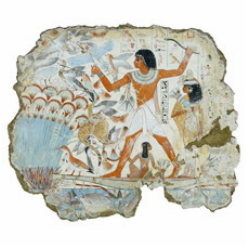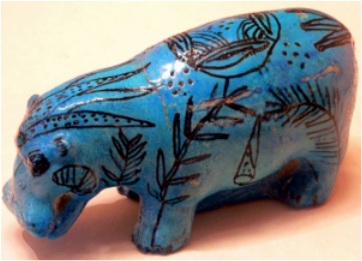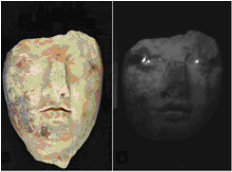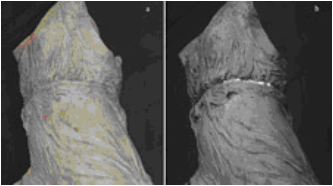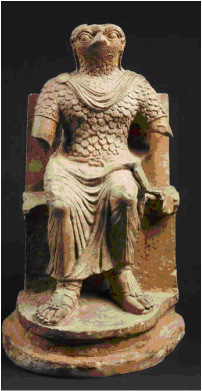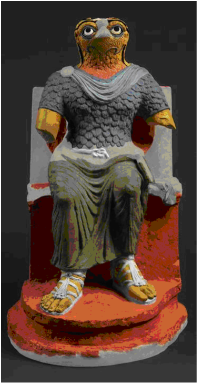Egyptian blue: the colour of technology
|
Recent scientific research has uncovered some extraordinary properties of the ancient pigment Egyptian blue that will enable us not only to reconstruct the past, but also possibly to shape the technological future.
First developed some 4,500 years ago, Egyptian blue – a bright blue crystalline substance (Fig 1) – is believed to be the earliest artificial pigment in human history [1]. |
More on Egypt or colours
The life and death of Mummy Brown Lost masterpieces of ancient Egyptian art The rescue of the fabulous lost library of Deir al-Surian The art of giraffe diplomacy Prussian blue and its partner in crime -------------------------------------------- |
The pigment is a synthetic form of the rare mineral cuprorivaite [2], and commonly also contains quantities of glass or quartz. It is made by heating to around 850-950C a mixture of a calcium compound (typically calcium carbonate), a copper-containing compound (metal filings or malachite), silica sand and soda or potash as a flux [3].
Because of the extreme rarity of naturally occurring cuprorivaite, the Egyptians could never have collected this pigment from nature. The precision and relative complexity of the procedure which must be followed to produce Egyptian blue therefore suggests that the ancient Egyptians’ grasp of chemistry was extraordinarily well advanced. Certainly, the Egyptians devoted more effort and skill into making artists’ colours than did any other civilization west of the Nile for several thousand years [4].
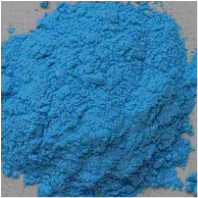 Fig 1: Modern synthesis of Egyptian blue: www.naturalpigments.com
Fig 1: Modern synthesis of Egyptian blue: www.naturalpigments.com
Egyptian blue was widely used in ancient times as a pigment in painting, such as in wall paintings, tombs and mummies’ coffins (Fig 2), and also as a ceramic glaze known as Egyptian faience (Fig 3) [5]. The fact that it was not available naturally meant that its presence indicated a work that had considerable prestige. Its use spread throughout Egypt, Mesopotamia, Greece, and the far reaches of the Roman Empire. It was often used as a substitute for lapis lazuli, an extremely expensive and rare mineral sourced in Afghanistan.
Following the collapse of the Roman Empire, the use of Egyptian blue declined sharply. From about 800 AD, it seemed that the pigment had – with some intriguing exceptions – virtually disappeared from art. Now, after more than a thousand years in the shadows, Egyptian blue has re-emerged in ways which its ancient inventors could never have dreamed of.
Reconstructing a colourful past
For art historians and conservators, the study of pigments used in artworks can be valuable in a number of ways. It can provide an indication of the age and the authenticity of the artwork, as well as of the studio practices of the painter. As precious pigments were often traded over long distances, it may also enable trade routes to be traced. And it can yield information which is vital in choosing which conservation treatments for the artwork may be the most effective [6].
In recent years, researchers at the British Museum, led by Giovanni Verri, have developed a simple yet effective method which enables them to identify traces of Egyptian blue on ancient objects that no longer have their original paint finishes intact [7]. The key to the effectiveness of the method is the researchers’ chance discovery that Egyptian blue has the highly unusual quality of emitting infrared light when red light is shone onto it. This emission is extraordinarily powerful and long-lived [8], but cannot be seen by the naked eye, because human vision does not normally extend into the infrared range of the light spectrum. However, the emission can be recorded using a digital camera with modified filters that enable it to detect only infrared light [9]. Viewed in this way, the emission takes on the form of a glowing, white photo-induced luminescence.
In recent years, researchers at the British Museum, led by Giovanni Verri, have developed a simple yet effective method which enables them to identify traces of Egyptian blue on ancient objects that no longer have their original paint finishes intact [7]. The key to the effectiveness of the method is the researchers’ chance discovery that Egyptian blue has the highly unusual quality of emitting infrared light when red light is shone onto it. This emission is extraordinarily powerful and long-lived [8], but cannot be seen by the naked eye, because human vision does not normally extend into the infrared range of the light spectrum. However, the emission can be recorded using a digital camera with modified filters that enable it to detect only infrared light [9]. Viewed in this way, the emission takes on the form of a glowing, white photo-induced luminescence.
|
As the emission is so strong, it is possible to see tiny traces of the pigment – even single grains, and even when they have become discoloured. This means not only that the presence of Egyptian blue can be identified - as in the detection of the originally blue eyes of the figure in in Fig 4 - but also that decorative patterns which would otherwise have been lost may possibly be able to be detected and reconstructed.
|
In addition, detection of the pigment will often be a clue that traces of other, less detectible, pigments may also survive on the artwork [10], [11].
The infrared imaging technique has recently been used to solve a longstanding mystery concerning the so-called “Elgin Marbles”—the sculptures that were detached from various buildings on the Acropolis and taken to England at the start of the 19th century. Although these sculptures have been held in the British Museum for some 200 years, and have been intensively studied during that time, no firm evidence had previously been found to support the view that the sculptures had originally been painted [12]. Indeed, senior curator Ian Jenkins has subsequently commented that after years of unsuccessful searching for traces of colour, he had been beginning to doubt that these traces had ever existed.
The infrared imaging technique has recently been used to solve a longstanding mystery concerning the so-called “Elgin Marbles”—the sculptures that were detached from various buildings on the Acropolis and taken to England at the start of the 19th century. Although these sculptures have been held in the British Museum for some 200 years, and have been intensively studied during that time, no firm evidence had previously been found to support the view that the sculptures had originally been painted [12]. Indeed, senior curator Ian Jenkins has subsequently commented that after years of unsuccessful searching for traces of colour, he had been beginning to doubt that these traces had ever existed.
|
Now the infrared imaging has settled the matter once and for all – the sculptures had indeed been painted.
Figure 5 shows our normal view of a statue of Iris, a messenger goddess, from the west pediment of the Parthenon, alongside its luminescent infrared image. |
Despite the apparent absence of visible colour on the statue, the image makes it clear that her belt was originally coloured Egyptian blue [13].
Another striking example, this time from Roman Egypt, is provided by a statue of Horus, the sun god and divine representative of the living king in Egyptian tradition. The statue reflects its mixed cultural origin by its strange mixture of Olympian deity (up to the neck) morphing into a vaguely humanoid head of a falcon. While close examination shows vestiges of some colours, it has taken infrared imaging to reveal the otherwise undetected presence of Egyptian blue used for the god’s feathered mail armour. Figures 5 and 6 compare the actual statue and an attempted reconstruction of its original colouring, presenting what to many modern viewers may seem a bizarrely garish appearance [14].
Another striking example, this time from Roman Egypt, is provided by a statue of Horus, the sun god and divine representative of the living king in Egyptian tradition. The statue reflects its mixed cultural origin by its strange mixture of Olympian deity (up to the neck) morphing into a vaguely humanoid head of a falcon. While close examination shows vestiges of some colours, it has taken infrared imaging to reveal the otherwise undetected presence of Egyptian blue used for the god’s feathered mail armour. Figures 5 and 6 compare the actual statue and an attempted reconstruction of its original colouring, presenting what to many modern viewers may seem a bizarrely garish appearance [14].
Shaping the high-tech future
While these discoveries are intriguing, the exceptionally strong luminescence of Egyptian blue has implications that go far beyond issues of art history or cultural heritage. Unlikely as it may seem, those same qualities may make the substance suitable for several high-tech applications in the fields of biomedical analysis, telecommunications and lasers [15].
For example, in the biomedical field, the near-infrared that Egyptian blue (or cuprorivaite) emits can typically penetrate much further into a human tissue sample than other methods, such as ultraviolet radiation. This offers the possibility of attaining more detailed and highly resolved images, while minimizing absorption by the affected tissue [16]. It also means that there are other potential applications – in silica-based optical amplifiers and fibreoptic systems for telecommunications, and in laser technology, where the generation of low energy light beams can form the basis of tunable solid-state lasers over a wide spectral range.
Egyptian blue’s potential was even further increased by yet another of its extraordinary qualities, only uncovered by research published in 2013. This revealed the surprising fact that, despite its remarkably stable nature, Egyptian blue “delaminates” by splitting into “nanosheets” – a thousand times thinner than a human hair – if stirred in warm water for several days [17]. Furthermore, this delamination does not affect the pigment’s exceptional luminescence. It is possible, therefore, that Egyptian blue could be used in the form of a dye for some of the applications mentioned above [18]. The researchers also suggest that the pigment’s luminescent quality could also be effective for developing new types of security ink, typically used to secure currencies and other official documents from forgery.
Still further applications of Egyptian Blue continue to be found. In 2016, forensic researchers discovered that the near-infrared (NIR) micronised pigment could be used to reveal latent fingerprints on highly patterned and reflective surfaces, consistently outperforming normal fingerprint powders used in crime investigations [18A]. Possible applications in the cooling of sunlit surfaces (to reduce air conditioning requirements) and luminescent solar concentrators are also being canvassed [18B].
For example, in the biomedical field, the near-infrared that Egyptian blue (or cuprorivaite) emits can typically penetrate much further into a human tissue sample than other methods, such as ultraviolet radiation. This offers the possibility of attaining more detailed and highly resolved images, while minimizing absorption by the affected tissue [16]. It also means that there are other potential applications – in silica-based optical amplifiers and fibreoptic systems for telecommunications, and in laser technology, where the generation of low energy light beams can form the basis of tunable solid-state lasers over a wide spectral range.
Egyptian blue’s potential was even further increased by yet another of its extraordinary qualities, only uncovered by research published in 2013. This revealed the surprising fact that, despite its remarkably stable nature, Egyptian blue “delaminates” by splitting into “nanosheets” – a thousand times thinner than a human hair – if stirred in warm water for several days [17]. Furthermore, this delamination does not affect the pigment’s exceptional luminescence. It is possible, therefore, that Egyptian blue could be used in the form of a dye for some of the applications mentioned above [18]. The researchers also suggest that the pigment’s luminescent quality could also be effective for developing new types of security ink, typically used to secure currencies and other official documents from forgery.
Still further applications of Egyptian Blue continue to be found. In 2016, forensic researchers discovered that the near-infrared (NIR) micronised pigment could be used to reveal latent fingerprints on highly patterned and reflective surfaces, consistently outperforming normal fingerprint powders used in crime investigations [18A]. Possible applications in the cooling of sunlit surfaces (to reduce air conditioning requirements) and luminescent solar concentrators are also being canvassed [18B].
The pigment's "missing" 1,000 years
So, it seems clear that Egyptian blue’s future may be bright, in more ways than one. But this pigment has also had an interesting history as well. We’ve already mentioned that the pigment seems to have faded out from recorded usage from about 800-900 AD. Possibly the last known examples we know of it continuing to be been made (as well as used) are provided by two Roman churches. In the first, the Church of San Clemente, the pigment appears in a Byzantine fresco The Ascension of Christ, dating from ca 850 AD. The poor quality of the pigment would tend to exclude it from being sourced from a reclaimed batch of genuine old Roman stock, so it seems that the pigment was most likely produced concurrently with the fresco [19].
A mixture of Egyptian blue and lapis lazuli also appeared in some 8th century wall paintings in the San Saba Church. This could also be the first occurrence of lapis lazuli as a pigment in European painting. The paintings appear to represent a merging of an oriental technique (the lapis from Afghanistan) and the local artistic tradition, which had until then almost exclusively employed Egyptian blue. This may suggest that the discontinuation of Egyptian blue and its replacement by lapis lazuli was a gradual process, and that both pigments could have coexisted over a period [20].
After these two appearances, however, it seems that the production technology for Egyptian blue was lost (or extremely localised) and that there was almost a thousand years in which Egyptian blue dropped out of recorded art history. Essentially, it was forgotten. Why did this occur? The main reason was probably the decline of the Roman Empire, with the consequent loss of the necessary knowledge and technologies [21]. It seems that this was coupled with a misunderstanding arising over the method of manufacture described by Vitruvius in De Architectura in the first century BC. Vitrivius had made no specific mention of the need for calcium carbonate (lime), probably because the particular sand used in the samples available to him happened to have the right limestone content. With sand from elsewhere, however, the method he described was totally ineffective, and the knowledge was lost.
This situation changed dramatically in the early 19th century. General and scientific interest in Egypt had already been piqued by the archaeological discoveries made by the Napoleon’s Egyptian expedition (see the Life and Death of Mummy Brown) and, in 1814, further research was spurred by the unearthing of a pot of mysterious “pale blue colour” at Pompeii, in the presence of the British chemist Humphrey Davy [22]. Eventually, in the 1880s, the chemical composition of the pigment was finally determined, and the mode of manufacture identified [23].
Armed with this rediscovered knowledge, researchers have been able to confirm that, in fact, Egyptian blue never disappeared completely, and actually was used in a number of medieval and even Renaissance paintings, even though its use went unrecorded at the time. In 2009, for example, researchers reported evidence for the use of Egyptian blue in an 11th century mural altarpiece in the Church of Sant Pere at Terrassa in Spain [24].
A mixture of Egyptian blue and lapis lazuli also appeared in some 8th century wall paintings in the San Saba Church. This could also be the first occurrence of lapis lazuli as a pigment in European painting. The paintings appear to represent a merging of an oriental technique (the lapis from Afghanistan) and the local artistic tradition, which had until then almost exclusively employed Egyptian blue. This may suggest that the discontinuation of Egyptian blue and its replacement by lapis lazuli was a gradual process, and that both pigments could have coexisted over a period [20].
After these two appearances, however, it seems that the production technology for Egyptian blue was lost (or extremely localised) and that there was almost a thousand years in which Egyptian blue dropped out of recorded art history. Essentially, it was forgotten. Why did this occur? The main reason was probably the decline of the Roman Empire, with the consequent loss of the necessary knowledge and technologies [21]. It seems that this was coupled with a misunderstanding arising over the method of manufacture described by Vitruvius in De Architectura in the first century BC. Vitrivius had made no specific mention of the need for calcium carbonate (lime), probably because the particular sand used in the samples available to him happened to have the right limestone content. With sand from elsewhere, however, the method he described was totally ineffective, and the knowledge was lost.
This situation changed dramatically in the early 19th century. General and scientific interest in Egypt had already been piqued by the archaeological discoveries made by the Napoleon’s Egyptian expedition (see the Life and Death of Mummy Brown) and, in 1814, further research was spurred by the unearthing of a pot of mysterious “pale blue colour” at Pompeii, in the presence of the British chemist Humphrey Davy [22]. Eventually, in the 1880s, the chemical composition of the pigment was finally determined, and the mode of manufacture identified [23].
Armed with this rediscovered knowledge, researchers have been able to confirm that, in fact, Egyptian blue never disappeared completely, and actually was used in a number of medieval and even Renaissance paintings, even though its use went unrecorded at the time. In 2009, for example, researchers reported evidence for the use of Egyptian blue in an 11th century mural altarpiece in the Church of Sant Pere at Terrassa in Spain [24].
|
This was an unexpected discovery, as the use of Egyptian blue had never before been documented in that region, nor on stone pre-Romanesque altarpieces of any kind, and all other pigments used on the altarpiece were common earth pigments. As no evidence for the production of Egyptian blue in Catalonia during the Middle Ages has been found, and the church was located on what was formerly a Roman settlement, the researchers have speculated that the Egyptian blue was added during an ancient restoration, by the re-use of Roman pigment found by the painters, either as powder or as balls.
In 2001, the presence of Egyptian blue was also reported in 16th century wall paintings at Bologna in Italy [25]. However, it has been suggested that this very late example of the use of Egyptian blue attests to an occasional revival of the lost tradition rather than a continuation of its usage [26]. |
Most recently, in 2011. the pigment, mixed with lapis lazuli, was identified in a 16th century Roman oil painting of St Margaret (Fig 8) by the Italian artist Ortolano Ferrarese [27]. The identification was confirmed by its “very intense” luminescence.
The researchers suggest that the reason why the two pigments were found together could be because of the high price of lapis lazuli. It is possible therefore that the Egyptian blue was used as a thinner, either by the pigment merchants or by the producers simply to reduce costs [28].
The researchers suggest that the reason why the two pigments were found together could be because of the high price of lapis lazuli. It is possible therefore that the Egyptian blue was used as a thinner, either by the pigment merchants or by the producers simply to reduce costs [28].
Conclusion
It is an understatement to say that Egyptian blue has had a chequered career -- originally the primary source of blue in a large part of the civilised world for three thousand years, then basically disappearing for another thousand, only to be rediscovered partly as a result of a chance finding. And today, with the revelation of its extraordinary and previously-unknown technical qualities, it appears set to be involved at the cutting edge of technological development.
Back in 1915, a prominent colour specialist concluded that “the interest attached to the subject of Egyptian blue is rather academic than practical, for this pigment is not now made except on a small laboratory scale” [29]. However true this may have been at the time, modern developments suggest that it may prove to be far from correct.
Note: For other articles on art colours, see The Life and Death of Mummy Brown and Prussian Blue and its Partner in Crime. On Egypt, see The art of giraffe diplomacy and Lost masterpieces of ancient Egyptian art from the Nebamun tomb-chapel
© Philip McCouat 2013, 2014, 2015 , 2016, 2018
Mode of citation: Philip McCouat, "Egyptian blue: the colour of technology", Journal of Art in Society, www.artinsociety.com
We welcome your comments on this article
Back in 1915, a prominent colour specialist concluded that “the interest attached to the subject of Egyptian blue is rather academic than practical, for this pigment is not now made except on a small laboratory scale” [29]. However true this may have been at the time, modern developments suggest that it may prove to be far from correct.
Note: For other articles on art colours, see The Life and Death of Mummy Brown and Prussian Blue and its Partner in Crime. On Egypt, see The art of giraffe diplomacy and Lost masterpieces of ancient Egyptian art from the Nebamun tomb-chapel
© Philip McCouat 2013, 2014, 2015 , 2016, 2018
Mode of citation: Philip McCouat, "Egyptian blue: the colour of technology", Journal of Art in Society, www.artinsociety.com
We welcome your comments on this article
End notes
[1] Assuming that we exclude charcoal. It is interesting that the Egyptians may also have been the only ancients with a word for "blue": see generally Guy Deutscher, Through the Language Glass, Arrow Books, London, 2010.
[2] Cuprorivaite was only discovered in modern times. Its chemical description is calcium-copper tetrasilicate: CaCuSi4O10 . The colour is also sometimes known as cerulean.
[3] Jaksch, H, et al, “Egyptian Blue – Cuprorivaite: A Window to Ancient Egyptian Technology”, Die Naturwissenschaften 70, 525-535 (1983); Accorsi, G et al, “The exceptional near-infrared luminescence of cuprorivaite (Egyptian blue)”, Chemical Communications Issue 23, 2009, 3392.
[4] Bell, P, Bright Earth: The Invention of Colour, Viking, London, 2001.
[5] This is different from the European faience, which is pottery glazed with tin oxide.
[6] Bredal-Jørgensen, J, et al, “Striking presence of Egyptian blue identified in a painting by Giovanni Battista Benvenuto from 1524”, Analytical and Bioanalytical Chemistry, Sep 2011 Vol 401 Iss 4, p 1433.
[7] Verri, G, “The spatially resolved characterisation of Egyptian blue, Han blue and Han purple by photo-induced luminescence digital imaging”, Analytical and Bioanalytical Chemistry, June 2009 Vol 394, Iss 4, pp 1011.
[8] Accorsi, op cit.
[9] Verri, op cit.
[10] “Imaging of Egyptian Blue: Technical Details”, at http://www.britishmuseum.org/pdf/Imaging%20of%20Egyptian%20Blue_Technical%20details.pdf; Accorsi, op cit. Egyptian blue’s exceptional capacity for extreme luminescence is shared by only two other blue/purple pigments, Han blue and Han purple. As it happens, those colours, which also are synthetic, are chemically very similar to Egyptian blue: Han purple (BaCuSi2O6) is one of the colours detected by chemical analysis on the Terracotta Warriors that were sensationally re-discovered in central China in 1974. It differs only slightly from Han blue (BaCuSi4O10) which, in turn, holds a striking visual resemblance and chemical composition to Egyptian blue. If Han blue’s barium is substituted for calcium, you have Egyptian blue: CaCuSi4O10: McMillan, Fiona, “The mysterious colour purple” Cosmos Magazine, 6 August 2009.
[11] For the use of Egyptian Blue as a background colouring in mummy portraits, see M Ganio et al, "Investigating the use of Egyptian blue in Roman Egyptian portraits and panels from Tebtunis, Egypt", Appl Phys. A, 14 August 2015; Megan Fellman, "Unusual use of blue pigment found in ancient mummy portraits", Popular Archaeology, 27 August 2015.
[12] It was, however, clear that the architectural structures that housed the sculptures were painted.
[13] The discovery of paint on the Parthenon sculptures in London complements recent reports by Greek specialists of newly found colour on some parts of the frieze in Athens; see C. Vlassopoulou, ‘Neue Untersuchungen zur Farbigkeit des Parthenon’ in Bunte Götter, Die Farbigkeit antiker Skulptur, Liebieghaus Skulpturensammlung, Frankfurt am Main (2008) 145-147. In general, the growing realisation that many Greek temples and sculptures were brightly coloured came as a shock to many.The sculptor Auguste Rodin is reputed to have responded to the suggestion by beating his chest, crying loudly, "I feel here that they were never coloured!" (Victoria Finlay, Colour: Travels through the Paintbox, The Folio Society, London, 2009 at 116.
[14] O’Connell, ER, “Pigment and power dressing in Roman Egypt” https://blog.britishmuseum.org/pigment-and-power-dressing-in-roman-egypt/ October 26, 2012. For other examples of detection through luminescence, see Verri, G, The use and distribution of Egyptian blue: a study by visible-induced luminescence imaging, in ed. K. Uprichard and A. Middleton, Conservation, scientific examination and re-display of the Nebamun wall paintings, Archetype, London, 2008; and Holly Lauridsen "'Digging'' for color: the search for Egyptian Blue in ancient reliefs, http://news.yale.edu/2014/05/05/digging-color-search-egyptian-blue-ancient-reliefs 5 May 2014.
[15] The following paragraph in the text is based on Accorsi, op cit.
[16] Moreover, the relatively long-lived luminescence makes it possible to cut off short-lived background emission from other sources.
[17] Johnson-McDaniel, D, et al, “Nanosacience of an Ancient Pigment”, Journal of the American Chemical Society, 2013, 135(5) pp 1677.
[18] Although other near-infrared-emitting materials exist, Egyptian blue is composed of abundant and inexpensive elements — calcium, copper, silicon, and oxygen — in contrast to other near-infrared-emitting materials that contain rare earth elements.
[18A] Roberto KIng et al, "NIR−NIR fluorescence: A new genre of fingermark visualisation techniques", Forensic Science International , Volume 262 (May 2016), e28 - e33; Benjamin Errington & Ors, "Micronised Egyptian blue pigment: A novel near-infrared luminescent fingerprint dusting powder", Dyes and Pigments, Vol 132, Sept 2016, 310 -313: available online at http://www.sciencedirect.com/science/article/pii/S014372081630198X; Curtin University Media Release, 24 May 2016 "Ancient pigment could help solve modern crime" http://news.curtin.edu.au/media-releases/ancient-pigment-help-solve-modern-crime/
[18B] Paul Berdahl et al, "High quantum yield of the Egyptian blue family of infrared phosphors (MCuSi4O10, M = Ca, Sr, Ba)", Journal of Applied Physics Vol 123, 193103 (2018). My thanks to Martin Adams for this reference.
[19] Lazzarini L, “The discovery of Egyptian blue in a Roman fresco of the mediaeval period (ninth century A.D.)”, Studies in Conservation, Vol 27 (1982) p84.
[20] Gaetani, MC et al, “The Use of Egyptian Blue and Lapis Lazuli in the Middle Ages: The Wall Paintings of the San Saba Church in Rome”, Studies in Conservation , Vol. 49, No 1 (2004), p 13.
[21] Mazzocchin GA et al, “A short note on Egyptian blue”, Journal of Cultural Heritage, 5 (2004), 129.
[22] Davy, Sir H, “Some experiments and observations on the colours used in painting by the ancients”, Philosophical Transactions of the Royal Society of London, vol. 105, p 97; Warner, TE, Synthesis, Properties and Mineralogy of Important Inorganic Materials, John Wiley & Sons, 2011, at 41.
[23] Tite, M S et al, (1984)“Technological examination of Egyptian blue” in Lambert JB (ed) Archaeological Chemistry 111, American Chemical Society, Washington 205-242.
[24] Lluveras, A et al. “Evidence for the use of egyptian blue in an 11th century mural altarpiece”, Archaeometry, Volume 52, Issue 2, p 308 (April 2010).
[25] Baraldi, P., Fagnano, C, Giordani, N., Pvoversi, P., and Tannini, P., 'Una testimonianza di blu egiziano nella Bologna del '500', poster presented at Archeometria e niondo classico (8a giornata su Le Scienze della Terra e I'Archeometria), Rome, Museo dell'Arte Glassica, 22-24 February 2001).
[26] Gaetani, op cit.
[27] The artist’s real name is Giovanni Battista Benvenuto, but he is often referred to as L’Ortolano Ferrarese, due to his father’s work as a gardener (ortolano = greengrocer), and his birthplace in Ferrara.
[28] Bredal, op cit.
[29] Church, Sir AH, The Chemistry of Paints and Painting, Seely, Serive and Co Ltd London, 1915, at 250. Accessed at: http://archive.org/stream/chemistryofpaint00churuoft#page/262/mode/2up
© Philip McCouat 2013, 2014, 2015, 2016, 2018
Mode of citation: Philip McCouat, "Egyptian blue: the colour of technology", Journal of Art in Society, www.artinsociety.com
Originally published August 2013
We welcome your comments on this article
Back to HOME
[2] Cuprorivaite was only discovered in modern times. Its chemical description is calcium-copper tetrasilicate: CaCuSi4O10 . The colour is also sometimes known as cerulean.
[3] Jaksch, H, et al, “Egyptian Blue – Cuprorivaite: A Window to Ancient Egyptian Technology”, Die Naturwissenschaften 70, 525-535 (1983); Accorsi, G et al, “The exceptional near-infrared luminescence of cuprorivaite (Egyptian blue)”, Chemical Communications Issue 23, 2009, 3392.
[4] Bell, P, Bright Earth: The Invention of Colour, Viking, London, 2001.
[5] This is different from the European faience, which is pottery glazed with tin oxide.
[6] Bredal-Jørgensen, J, et al, “Striking presence of Egyptian blue identified in a painting by Giovanni Battista Benvenuto from 1524”, Analytical and Bioanalytical Chemistry, Sep 2011 Vol 401 Iss 4, p 1433.
[7] Verri, G, “The spatially resolved characterisation of Egyptian blue, Han blue and Han purple by photo-induced luminescence digital imaging”, Analytical and Bioanalytical Chemistry, June 2009 Vol 394, Iss 4, pp 1011.
[8] Accorsi, op cit.
[9] Verri, op cit.
[10] “Imaging of Egyptian Blue: Technical Details”, at http://www.britishmuseum.org/pdf/Imaging%20of%20Egyptian%20Blue_Technical%20details.pdf; Accorsi, op cit. Egyptian blue’s exceptional capacity for extreme luminescence is shared by only two other blue/purple pigments, Han blue and Han purple. As it happens, those colours, which also are synthetic, are chemically very similar to Egyptian blue: Han purple (BaCuSi2O6) is one of the colours detected by chemical analysis on the Terracotta Warriors that were sensationally re-discovered in central China in 1974. It differs only slightly from Han blue (BaCuSi4O10) which, in turn, holds a striking visual resemblance and chemical composition to Egyptian blue. If Han blue’s barium is substituted for calcium, you have Egyptian blue: CaCuSi4O10: McMillan, Fiona, “The mysterious colour purple” Cosmos Magazine, 6 August 2009.
[11] For the use of Egyptian Blue as a background colouring in mummy portraits, see M Ganio et al, "Investigating the use of Egyptian blue in Roman Egyptian portraits and panels from Tebtunis, Egypt", Appl Phys. A, 14 August 2015; Megan Fellman, "Unusual use of blue pigment found in ancient mummy portraits", Popular Archaeology, 27 August 2015.
[12] It was, however, clear that the architectural structures that housed the sculptures were painted.
[13] The discovery of paint on the Parthenon sculptures in London complements recent reports by Greek specialists of newly found colour on some parts of the frieze in Athens; see C. Vlassopoulou, ‘Neue Untersuchungen zur Farbigkeit des Parthenon’ in Bunte Götter, Die Farbigkeit antiker Skulptur, Liebieghaus Skulpturensammlung, Frankfurt am Main (2008) 145-147. In general, the growing realisation that many Greek temples and sculptures were brightly coloured came as a shock to many.The sculptor Auguste Rodin is reputed to have responded to the suggestion by beating his chest, crying loudly, "I feel here that they were never coloured!" (Victoria Finlay, Colour: Travels through the Paintbox, The Folio Society, London, 2009 at 116.
[14] O’Connell, ER, “Pigment and power dressing in Roman Egypt” https://blog.britishmuseum.org/pigment-and-power-dressing-in-roman-egypt/ October 26, 2012. For other examples of detection through luminescence, see Verri, G, The use and distribution of Egyptian blue: a study by visible-induced luminescence imaging, in ed. K. Uprichard and A. Middleton, Conservation, scientific examination and re-display of the Nebamun wall paintings, Archetype, London, 2008; and Holly Lauridsen "'Digging'' for color: the search for Egyptian Blue in ancient reliefs, http://news.yale.edu/2014/05/05/digging-color-search-egyptian-blue-ancient-reliefs 5 May 2014.
[15] The following paragraph in the text is based on Accorsi, op cit.
[16] Moreover, the relatively long-lived luminescence makes it possible to cut off short-lived background emission from other sources.
[17] Johnson-McDaniel, D, et al, “Nanosacience of an Ancient Pigment”, Journal of the American Chemical Society, 2013, 135(5) pp 1677.
[18] Although other near-infrared-emitting materials exist, Egyptian blue is composed of abundant and inexpensive elements — calcium, copper, silicon, and oxygen — in contrast to other near-infrared-emitting materials that contain rare earth elements.
[18A] Roberto KIng et al, "NIR−NIR fluorescence: A new genre of fingermark visualisation techniques", Forensic Science International , Volume 262 (May 2016), e28 - e33; Benjamin Errington & Ors, "Micronised Egyptian blue pigment: A novel near-infrared luminescent fingerprint dusting powder", Dyes and Pigments, Vol 132, Sept 2016, 310 -313: available online at http://www.sciencedirect.com/science/article/pii/S014372081630198X; Curtin University Media Release, 24 May 2016 "Ancient pigment could help solve modern crime" http://news.curtin.edu.au/media-releases/ancient-pigment-help-solve-modern-crime/
[18B] Paul Berdahl et al, "High quantum yield of the Egyptian blue family of infrared phosphors (MCuSi4O10, M = Ca, Sr, Ba)", Journal of Applied Physics Vol 123, 193103 (2018). My thanks to Martin Adams for this reference.
[19] Lazzarini L, “The discovery of Egyptian blue in a Roman fresco of the mediaeval period (ninth century A.D.)”, Studies in Conservation, Vol 27 (1982) p84.
[20] Gaetani, MC et al, “The Use of Egyptian Blue and Lapis Lazuli in the Middle Ages: The Wall Paintings of the San Saba Church in Rome”, Studies in Conservation , Vol. 49, No 1 (2004), p 13.
[21] Mazzocchin GA et al, “A short note on Egyptian blue”, Journal of Cultural Heritage, 5 (2004), 129.
[22] Davy, Sir H, “Some experiments and observations on the colours used in painting by the ancients”, Philosophical Transactions of the Royal Society of London, vol. 105, p 97; Warner, TE, Synthesis, Properties and Mineralogy of Important Inorganic Materials, John Wiley & Sons, 2011, at 41.
[23] Tite, M S et al, (1984)“Technological examination of Egyptian blue” in Lambert JB (ed) Archaeological Chemistry 111, American Chemical Society, Washington 205-242.
[24] Lluveras, A et al. “Evidence for the use of egyptian blue in an 11th century mural altarpiece”, Archaeometry, Volume 52, Issue 2, p 308 (April 2010).
[25] Baraldi, P., Fagnano, C, Giordani, N., Pvoversi, P., and Tannini, P., 'Una testimonianza di blu egiziano nella Bologna del '500', poster presented at Archeometria e niondo classico (8a giornata su Le Scienze della Terra e I'Archeometria), Rome, Museo dell'Arte Glassica, 22-24 February 2001).
[26] Gaetani, op cit.
[27] The artist’s real name is Giovanni Battista Benvenuto, but he is often referred to as L’Ortolano Ferrarese, due to his father’s work as a gardener (ortolano = greengrocer), and his birthplace in Ferrara.
[28] Bredal, op cit.
[29] Church, Sir AH, The Chemistry of Paints and Painting, Seely, Serive and Co Ltd London, 1915, at 250. Accessed at: http://archive.org/stream/chemistryofpaint00churuoft#page/262/mode/2up
© Philip McCouat 2013, 2014, 2015, 2016, 2018
Mode of citation: Philip McCouat, "Egyptian blue: the colour of technology", Journal of Art in Society, www.artinsociety.com
Originally published August 2013
We welcome your comments on this article
Back to HOME
